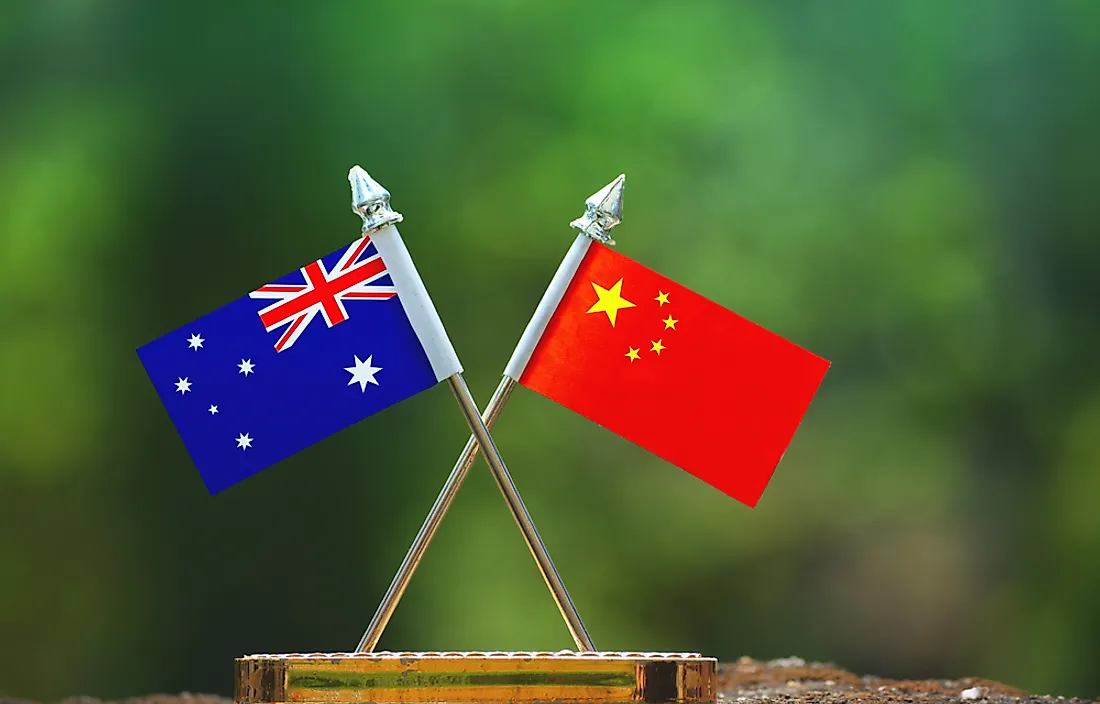Australia's Biggest Trading Partners

The economy of Australia is the 12th largest economy in the world by nominal gross domestic product (GDP), which in 2015 was $1.62 trillion. In 2014, this country was considered the 21st largest export economy in the world. Australia participates in trade with a number of countries around the world. This article takes a look at the country’s top two-way trade partners, which takes into account both imports and exports.
China
Australia’s biggest two-way trade partner is China. Its exports to China are valued at $98.2 billion and its imports from China are worth $54.3 billion. This gives Australia a $44 billion positive trade balance with this country. Approximately 34% of Australia’s total exports go to China.
The largest percentage of these exports includes the following products: iron ore ($46 billion), coal briquettes ($7.74 billion), gold ($6.34 billion), crude petroleum ($1.89 billion), and refined copper ($1.88 billion). In return, approximately 21% of the imports that Australia receives originate in China. The principal imports include: computers ($5.06 billion), broadcasting equipment ($2.96 billion), telephones ($1.43 billion), other furniture ($966 million), and seats ($814 million).
Japan
Japan is listed as the second largest trade partner of Australia. In fact, in April of 2014, the governments of Australia and Japan signed a free trade agreement after nearly a decade of negotiations. This agreement was the first of its kind between Japan and a major agricultural exporting country. The two countries shared a $70.2 billion trade value in 2014. When broken down, this makes Japan the second largest export partner and the third largest import partner. Australia exported $50.2 billion worth of goods to Japan in 2014 and imported $20 billion, giving Australia a $30.3 billion positive trade balance. Approximately 18% of its total exports go to Japan and 7% of its imports originate there.
The largest percentage of these exports includes the following products: petroleum gas ($14.4 billion), coal briquettes ($10.7 billion), iron ore ($7.58 billion), copper ore ($1.41 billion), and crude petroleum ($925 million). Australia’s principal imports from Japan include: cars ($5.32 billion), refined petroleum ($2.37 billion), delivery trucks ($1.15 billion), other large pipes ($562 million), and rubber tires ($499 million).
United States
The US is Australia’s third biggest trading partner. The two-way trade between these countries was valued at $60.4 billion in 2014. Australia exported $18.5 billion worth of goods to the US and imported $41.9 billion, giving Australia a $23.4 billion negative trade balance. These figures make the US Australia’s fourth largest export partner and second largest import partner. Approximately 4.1% of its total exports go to the US and 11% of its imports originate there.
The largest percentage of these exports includes the following products: frozen bovine meat ($1.53 billion), sheep and goat meat ($576 million), aircraft parts ($515 million), bovine meat ($502 million), and wine ($435 million). Australia’s principal imports from the US include: cars ($2 billion), medical instruments ($913 million), packaged medicines ($912 million), telephones ($545 million), and computers ($543 million).
A complete list of Australia’s top 10 biggest trading partners can be found in the chart published below.
Which Countries Are The Biggest Trading Partners Of Australia?
| Rank | Country/District | Exports | Imports | Total Trade | Trade Balance |
|---|---|---|---|---|---|
| 1 | China | 98.2 | 54.3 | 153.5 | 44.0 |
| 2 | Japan | 50.2 | 20.0 | 70.2 | 30.3 |
| 3 | United States | 18.5 | 41.9 | 60.4 | -23.4 |
| 4 | South Korea | 22.0 | 12.6 | 34.6 | 9.4 |
| 5 | Singapore | 12.1 | 18.1 | 30.2 | -6.0 |
| 6 | New Zealand | 12.1 | 11.3 | 23.5 | 0.7 |
| 7 | United Kingdom | 8.3 | 12.5 | 20.8 | -4.1 |
| 8 | Malaysia | 7.9 | 12.7 | 20.6 | -4.7 |
| 9 | Thailand | 6.1 | 12.9 | 19.0 | -6.8 |
| 10 | Germany | 2.9 | 13.9 | 16.8 | -11.0 |











